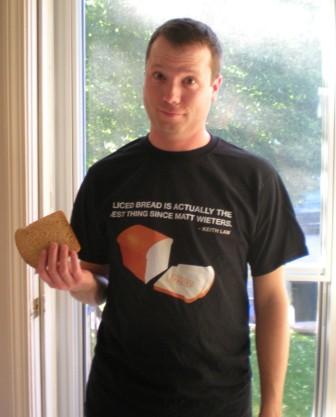UPDATE: Folks, the line about Old Hoss Radbourn being my alter ego is a joke. I’m not Hoss, but he and I have had some fun with the rumor that I am. He’s incredibly clever and I’m flattered to be thought the source, but it’s not me.
—
I received a comp copy of Dave Jamieson’s Mint Condition: How Baseball Cards Became an American Obsession back in the spring through my connection with the guys at mental floss, but got backed up in my reading between the move and writing playoff previews that I just got around to the book now. If you’ve got any history of collecting baseball cards (I do) or an interest in that tangential part of baseball history, I highly recommend the book, a quick, fun, occasionally funny run through the history of the baseball card, one that disabused me of a handful of card myths I thought were true.
Jamieson, who must be roughly my age as he too collected a hoard of cards that are no longer worth the cardboard they’re printed on, goes back to the origins of the baseball card as a way to sell tobacco, allegedly to adults but, hey, if a few kids caught the leaf habit, so much the better. Many of those tobacco cards are, of course, major collectors’ items today, but what I didn’t realize is that they’re rare not just because they weren’t kept but because they varied so widely – manufacturers would issue many different cards per player, with different brands advertised on the backs or different portraits on the fronts, for example. Jamieson discusses the history and myth behind the T206 Honus Wagner card, but also points out that it’s not the rarest card in history (another card in the same set, the T206 “Slow” Joe Doyle error card, is definitely rarer). Instead, Jamieson posits, the Wagner card became more valuable because it was deemed valuable in the first place: The media attention paid to the card when it sold for record-breaking sums made it more desirable to other, status-seeking collectors down the road.
He jumps forward a bit to the period after World War II when the card industry really boomed with the introduction of Bowman and Topps cards, as well as the latter’s monopolization of the industry that lasted until Fleer won an antitrust lawsuit in 1981. Topps’ actions to create and defend a monopoly occurred at the same time that the MLB Players’ Association was getting started, and while at first the MLBPA was willing to let Topps have its run of the joint, Marvin Miller’s first order of business was to end Topps’ free ride and begin returning that lost value to the players – making the union, which was battling one monopoly in MLB management, a willing partner to another monopoly in the baseball card realm. From there, Jamieson chronicles the rise and fall of the collectors’ boom in baseball cards, drawing much of his material from Pete Williams’ 1995 book Card Sharks, on the formation of Upper Deck and the creative destruction it brought to the baseball card industry, a very good story in its own right.
Jamieson keeps the book from turning into dry history by, naturally, finding and discussing a few notable eccentrics along the way. I particularly enjoyed the section on Woody Gelman, longtime head of Topps’ Product Development team and the creator of, among other icons, Bazooka Joe and the Mars Attacks! series. (I remember seeing Topps’ Wacky Packages as a kid, possibly the first time I ever ran into (or understood) parody in any form, but I don’t think I realized until I read this book that they were a Topps product.) Jamieson also takes us inside the collection of a former owner of that T206 Wagner, and looks at the rise of both card auction outfits, card authentication services, and the “ethical” card doctor who doctors worthless cards to better understand how fraudsters do it to create valuable ones. And I’d be remiss if I omitted the part my alter ego friend Old Hoss Radbourn played in the book, with a quietly extended middle finger in a few early cards of himself. That’s right: Old Hoss may have invented photobombing.
The book ends with a lament on the slow death of baseball cards, a phenomenon for which Jamieson explores various causes but can’t pinpoint a single reason for boys’ lack of interest in something so innate to his (and my) childhood. (I will offer that steroids have jack squat to do with it, since interest in MLB and minor league baseball grew substantially during the “steroid era.”) I do agree with his point that cheapening the core product by adding “chase cards” – prizes, limited edition cards, or other package inserts that weren’t just plain old cards of everyday players – didn’t help, but I think the fact that the cards themselves lack any interactivity is a huge part of why they’ve fallen so far out of favor. If you’re a kid today, what are you going to do with a pack of baseball cards? There’s no game or challenge involved, and I’d be hard-pressed to explain to an 8-year-old boy why I thought baseball cards were fun. They just were. The cards haven’t really changed, but maybe the definition of fun has.
At about 240 pages, Mint Condition is a very quick read, well under four hours for me, but in that short space it managed to fill a gap in my knowledge of baseball history, one I doubt I would have explored on my own since I left my baseball card affinity back the 1980s. Aside from the unsatisfying conclusion and some need for a better copyeditor, it’s well worth your time.
Next up: I’m crawling through the desert of Abdelrahman Munif’s Cities of Salt.
